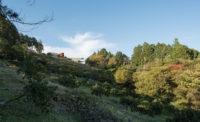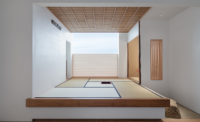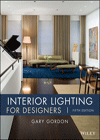San Francisco, California
Mark Cavagnero Associates and de Young Museum
When New York–based photographer Hiroshi Sugimoto first arrived in his adopted city in the mid-1970s, he spent long nights in empty cinemas, capturing the entire running time of films in single long-exposure shots. Sugimoto’s silver screens radiate ethereal white light in a deceptively simple effect achieved through exacting effort—and the same can be said of the 2007 Sugimoto retrospective designed by San Francisco’s de Young Museum in consultation with architecture firm Mark Cavagnero Associates.
The lighting design needed to complement Sugimoto’s own virtuoso effects, from his blurred vision of the Twin Towers to a photograph of a Henry VIII waxwork spotlit to resemble Hans Holbein’s 16th-century portrait of the king. The de Young’s Herzog & de Meuron structure also presented constraints: The wooden floors couldn’t be marred, anchors couldn’t be attached to the walls, and a flat back wall couldn’t be modified. To satisfy the San Francisco Building Department, all built structures had to be able to withstand seismic events.
In-house designers Bill White and Bill Huggins replicated the lighting techniques Sugimoto had mastered over his 40-year career. For example, in his image of King Henry VIII, Sugimoto had recreated the illusion of Holbein’s eerie candle-lighting, and any reflection off the glass or misdirected modern spotlighting could spoil the effect; a lone PAR36 12-volt tungsten incandescent light was used to avoid double shadow and echo the nocturnal lighting scheme. To set a more somber tone in the room containing Sugimoto’s hazy images of war monuments and the Twin Towers, Huggins used window screening to diffuse additional PAR36s. And for Sugimoto’s signature cinemas, installers positioned the highest value of spotlighting on the glowing white movie screens at the center of the picture plane, subtly enhancing the dark edges of Sugimoto’s long-exposure images.
The retrospective had been previously installed at the Hirshhorn Museum, in Washington, D.C., whose rounded gallery walls suggested a curvature of the earth that made a fitting backdrop for silvery, pristine seascapes so untouched by human encroachment that Sugimoto refers to them as “prehistoric.” To adapt the seascapes to the de Young’s flat surfaces, White called in architect Mark Cavagnero, FAIA, who worked with the de Young and builders to devise a wide, modular curved wall 3 feet deep. Cavagnero says of the creation, “The whole thing could sit on a Neoprene pad so it didn’t damage the wood floor, and its own weight and girth would secure it for a seismic event.” Another concern was circulation through the gallery at this pivotal point. “Then it was a question about how to get the curvature strong enough so that it reads, but not so strong that it pinches circulation,” Cavagnero says.
This alone would have been a clever workaround, but there was an additional puzzle piece to consider. Behind the wide curved wall, it would be difficult to illuminate the wall-length black-and-white phalanx of beatific statues, 1000 Buddhas, against the flat gallery wall opposite it. As the architect explains, “This curved wall was 12 feet high, and the lights would be at such a steep angle that there would be glaring and crowning over the face of the photographs.” So instead, Cavagnero suggested cutting a channel through the back of the curved wall. This niche would be fitted with fiber-optic lighting to provide a uniform glow across the piece—essential to capture the repetitive, meditative nature of Sugimoto’s image of the sacred sculptures. The structure was coated in a dark gray paint that evened out the light further.
Builders constructed sturdy wall modules that were seamlessly joined on-site, and in the three-day lighting installation, fitted fiber optics under the lip of the long niche. When the switch was flipped at the opening, Sugimoto’s Buddhas emitted an otherworldly aura. On the front of the wall hung Sugimoto’s seascapes, lit with Altman Micro Ellipse frame projectors with MR16 halogens hung from a ceiling track so that these images also seemed to glow from within. Incredulous visitors inspected the sides of the seascapes, convinced that these photographs must be light boxes. Sugimoto’s photographic illusions remained mysteriously intact, betraying no suggestion of the elaborate schemes that brought them so vividly to life—a tribute to the artist and exhibition designers alike.
PeopleArchitect Project team: Engineer Lighting designer Photographer General contractor
|
ProductsPaints and stains Fiber optic light bars MR16 quartz projectors |





